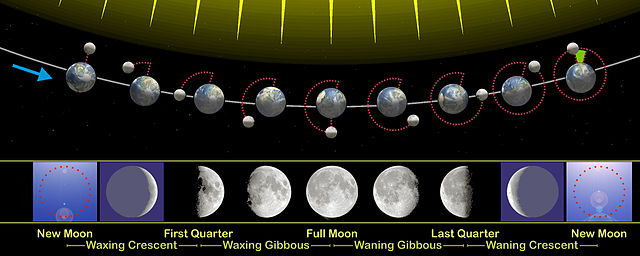The full moon is the lunar phase when the Moon appears fully illuminated from Earth's perspective. This occurs when Earth is located between the Sun and the Moon. This means that the lunar hemisphere facing Earth—the near side—is completely sunlit and appears as an approximately circular disk. The full moon occurs roughly once a month.
The supermoon of 14 November 2016 was 356,511 km (221,526 mi) away from the center of Earth. This occurs yearly.
A full moon rising, seen through the Belt of Venus
A harvest moon. Its orange color is due to greater Rayleigh scattering as the Moon appears close above the horizon, rather than being unique to harvest moons.
A lunar phase or Moon phase is the apparent shape of the Moon's directly sunlit portion as viewed from the Earth. In common usage, the four major phases are the new moon, the first quarter, the full moon and the last quarter; the four minor phases are waxing crescent, waxing gibbous, waning gibbous, and waning crescent. A lunar month is the time between successive recurrences of the same phase: due to the eccentricity of the Moon's orbit, this duration is not perfectly constant but averages about 29.5 days.
A full moon sets behind San Gorgonio Mountain in California on a midsummer's morning.
The phases of the Moon as viewed looking southward from the Northern Hemisphere. Each phase would be rotated 180° if seen looking northward from the Southern Hemisphere. The upper part of the diagram is not to scale, as the Moon, the Earth, and the Moon's orbit are all much smaller relative to the Earth's orbit than shown here.
An overexposed photograph of a crescent Moon reveals earthshine and stars.
A crescent Moon over Kingman, Arizona







